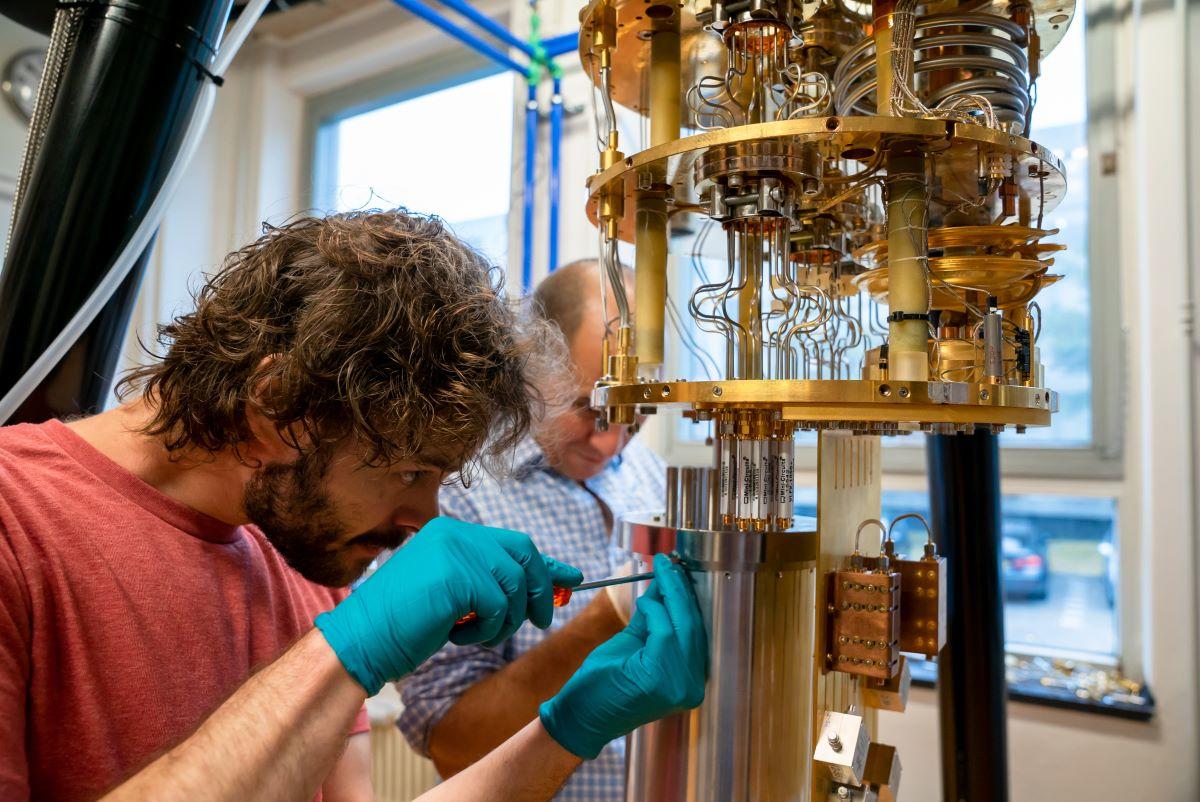
Intel teamed up with QuTech to work on another approach to quantum control.
Image: Tim Herman / Intel CorporationIntel's quantum computing efforts are starting to show tangible results: two years after the company first unveiled its Horse Ridge cryogenic control chip, researchers have demonstrated that the technology is delivering on its original promise, and paving the way for quantum computers to become more practical.
Practicality, in effect, is not quantum devices' most remarkable trait. In their current format, quantum computers rely on quantum chips that need to be cooled down to extreme temperatures, in order to exert better control over the fragile qubits on the processor. Typically, qubits operate at 20 millikelvin, or about –273 degrees Celsius – temperatures that are even colder than outer space.
But to interact with the qubits, whether to control their behavior or read their state, flesh-and-bone scientists work in room-temperature environments, with room-temperature instruments. And since control electronics struggle to perform well at cryogenic temperatures, each qubit has to be linked to the instruments with a single wire.
It's easy to see why the set-up might become problematic as scientists contemplate the possibility of scaling up quantum computers to millions of qubits. This hurdle has become known as the "wiring bottleneck".
This is why, a few years ago, Intel teamed up with QuTech – a collaboration between Delft University of Technology and the Netherlands Organization for Applied Scientific Research – to work on another approach to the problem.
It took the form of a new control chip designed to withstand the cold and operate as close as possible to the quantum processor, which Intel unveiled for the first time in 2019. The device was named Horse Ridge – a reference to the coldest place in Oregon, which is also the state where the Intel lab resides.
Horse Ridge was built on Intel's 22-nanometer FinFET Low Power technology, and was presented as a potential way to bring key control functions for quantum computer operations directly into the cryogenic refrigerator, closer to the qubits themselves.
The underlying premise was that, if Horse Ridge could achieve the same level of control as room-temperature instruments, then the wiring bottleneck could be significantly reduced.
Horse Ridge was subsequently tweaked, and a second generation of the chip was showcased last year; but now, for the first time, Intel's researchers have demonstrated that the technology is as capable of controlling qubits as its room-temperature-based equivalents.
The research team used Horse Ridge to run a two-qubit algorithm called the Deutsch-Jozsa algorithm, and found that the cryogenic chip performed well despite the cold environment, and achieved control of the qubits with a same level of fidelity (99.7%) as room-temperature electronics.
"Our research results, driven in partnership with QuTech, quantitatively prove that our cryogenic controller, Horse Ridge, can achieve the same high-fidelity results as room-temperature electronics while controlling multiple silicon qubits," said Stefano Pellerano, principal engineer at Intel Labs.
Horse Ridge is a silicon-based CMOS chip, and as such was designed with a technology similar to that used in conventional microprocessors. The device was adapted to ensure the right operation even at cryogenic temperatures, which enables the chip to manipulate the state of qubits thanks to radio frequency pulses.
The qubits manipulated by Horse Ridge are also silicon-based, contrary to the type of qubits that can be found, for example, in IBM or Google's quantum computers, which are superconducting qubits. While Intel initially pursued both approaches – superconducting as well as silicon qubits – the company's recent efforts have ramped up in the latter.
This is because researchers are increasingly acknowledging that building quantum computers with techniques that are similar in nature to those used to produce most modern-day electronics could come with huge advantages when it comes to scaling the technology.
What's more: with both qubits and the controller chip fabricated in silicon, Intel's researchers are hoping that it may be possible to one day fully integrate them both together in one die or package. This would greatly simplify the wiring challenge of quantum and enable strides in quantum scalability.
"These innovations pave the way for fully integrating quantum control chips with the quantum processor in the future, lifting a major roadblock in quantum scaling," said Pellerano.
With these new results, Intel is cementing the company's position in the fast-evolving quantum ecosystem. While much of the focus remains on the qubits themselves, and on improving quantum processors, the Santa Clara giant has established that it is adopting a different course of action, instead working on developing the interconnects and control electronics that will create a quantum stack.
Integrating those systems, according to Intel, will be as important a piece of the puzzle to achieve quantum practicality.
"control" - Google News
May 13, 2021 at 09:02PM
https://ift.tt/2SOtbLF
Quantum computing: Intel's cryogenic chip shows it can control qubits even in a deep freeze - ZDNet
"control" - Google News
https://ift.tt/3bY2j0m
https://ift.tt/2KQD83I
Bagikan Berita Ini














0 Response to "Quantum computing: Intel's cryogenic chip shows it can control qubits even in a deep freeze - ZDNet"
Post a Comment